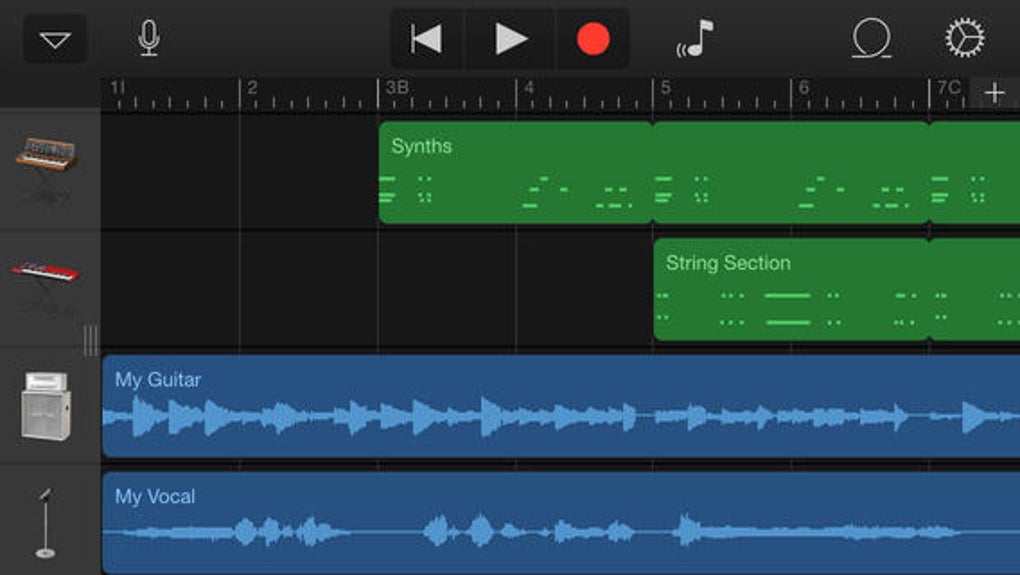Import a song from the Music app into GarageBand for iPad. You can import songs from the Music app on your iPad into Tracks view. You can import a song to an existing Audio Recorder or Amp track, or have GarageBand create a new Audio Recorder track for the song. Sep 14, 2014 I have an iMovie track of me singing and playing guitar. I understand that I can import this into Garageband and then add sound tracks etc; to it and when finished I export it to Movie. Will I then be able to upload it to youtube? Thanks for your help and patience 🙂 martin. Using Apple’s GarageBand app on the iPhone or iPad, you can easily assemble a song. In this chapter from iPad and iPhone Video: Film, Edit, and Share the Apple Way, learn how to calculate tempo from movie length, build a soundtrack using loops, record your own material, and share the song using iMovie. GarageBand uses the GarageBand File Transfer folder to store audio files that you can import into GarageBand or use with other music apps. You can copy the GarageBand File Transfer folder to your Mac to create a backup or to use the contents with other apps.
Home > Articles
␡- Share the Song with iMovie
How To Import Garageband Files Into Imovie On Ipad Free
Garageband Loops
This chapter is from the book This chapter is from the book
This chapter is from the book
Share the Song with iMovie
When it’s time to get your musical masterpiece out of GarageBand and into iMovie, you can share the song directly between apps.
Sharing a song with iMovie is a relatively simple process.
- Open the My Songs browser.
Tap Select, and tap the song you want to open in iMovie (4.29).
4.29 Yes, those icons are askew. They shake when you’re in the selection mode.
- Tap the Share button.
- Tap the Open In button.
Enter the optional artist, composer, and album info, and select an appropriate audio quality (4.30).
- Tap Share. GarageBand exports the song.
When prompted, select Open in iMovie (4.31).
4.31 Open in iMovie.
In iMovie, select a project or create a new movie (4.32). The song is dropped onto the audio track (4.33).
4.33 Song added in iMovie
Going Further with GarageBand
Since this book is about video and not music, it isn’t possible to cover all the nuances of GarageBand here. There are, however, great resources available, even within the program itself. The manual is always only a few taps away. On the iPad, tap the Info button, and then tap “Learn more about the control bar.” You can access the complete manual by tapping the Table of Contents icon in the upper left, or search the manual by tapping the Search button. On the iPhone, tap the Settings button and scroll to the bottom of the Song settings to open GarageBand Help.
The iOS version of GarageBand has a lot of great features, but many more editing and mixing options are available on the Mac version. To share a GarageBand for iOS project with GarageBand for Mac, you have two options: iCloud and iTunes.
Share via iCloud
To share a project via iCloud, navigate to the My Songs window and tap Select. Choose the song, tap the iCloud button, and choose Upload Song to iCloud (4.34, on the next page). The song becomes available on all devices that use your iCloud account.
Share via iTunes
Guitar on ipad garageband. In this scenario, iTunes acts as a go-between to transfer the project file from the iPhone or iPad to GarageBand on the Mac.

- Open the My Songs window and select the project.
This time, tap the Share icon and select iTunes, then choose the GarageBand option to save the multitrack GarageBand project (4.35).
4.35 Saving the file for iTunes
The song’s file is saved in a special storage area of the device reserved for GarageBand that iTunes can access.
- Connect your iOS device to your computer.
- On your Mac, select the device in iTunes and click the Apps tab.
- Scroll down to the File Sharing section and click the GarageBand icon.
Select the project and drag it to your desktop; or, click the Save To button and choose a location (4.36).
You may see a message saying that GarageBand has to download additional content to your Mac for compatibility. This shouldn’t take long, and only has to happen the first time you open GarageBand for iOS projects on your Mac.
Related Resources
- Book $47.99
- eBook (Watermarked) $38.39
- Book $47.99
GarageBand User Guide for iPad
You can import songs from the Music app on your iPad into Tracks view. You can import a song to an existing Audio Recorder or Amp track, or have GarageBand create a new Audio Recorder track for the song.
Songs imported from the Music app do not follow tempo changes you make in GarageBand.
Import a song from the Music app
To import the entire song, set the current song section to Automatic; otherwise, only the portion of the song that fits the current song section is imported.
To get a list of tracks, tap the Tracks View button .
Tap the Loop Browser button in the control bar, then tap Music.
You can search for songs by name, or browse by album, artist, genre, or playlist.
To preview a song, tap it in the list. You can control the preview volume with the slider at the bottom of the list.
Drag a song from the list to Tracks view. Align the left edge of the song with the bar or beat on the ruler where you want it to start playing.
After importing the song, you can make the song section longer, then resize the imported region so that more of the song plays.